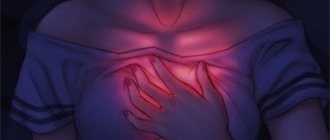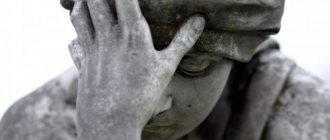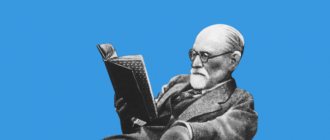What is the will to die
Long before Freud, many philosophers thought about what exactly determines human life and what role drives play in it.
At first, Freud considered only sexual attraction, which, in his opinion, combines a polar pair - creative love and the desire for destruction. From this he concluded that human activity is determined by the intertwining of the “instincts of life and death” - the forces of eros and thanatos, named after the Greek gods of love and death. These forces are the basic unconscious drives that predetermine all human life. Eros is considered a life-giving force, and this does not raise questions, but why is thanatos called the same? Freud suggested the existence of the death instinct, based on the idea of the evolution of all living things: having reached the maximum of organic existence, it eventually begins the way back and after death returns to the inorganic state. According to this hypothesis, the desire to preserve life forms in a living organism its own path to death. Freud formulated this position as follows: “The goal of all life is death.”
Philosophers Jacques Lacan and Friedrich Nietzsche talk about the death instinct as an aggression inherent in any person from birth. In his work “Aggression in Psychoanalysis,” Lacan describes the cruelty that people hide in their psyche, and illustrates it with the works of Hieronymus Bosch, where one can “recognize an atlas of all those aggressive images that disturb people.”
Vices and passions have always been the object of artistic depiction. But the theme of sex and various forms of violence in art are not an end in themselves, but only a device necessary to reveal the social or personal drama of the hero. It is no coincidence that many modern Western writers and film directors, in response to accusations of abuse of crime episodes, refer to the plays of Shakespeare or the novels of Zola.
One of the leaders of poststructuralism, Jean Baudrillard, in his work “Symbolic Exchange and Death,” considers the attraction to death as a kind of abstract idea, which is based on a certain culture of death accepted in society. This culture is largely mythological in nature and requires interpretation.
Cause of occurrence
Endorphin-enkephalin imbalance of brain neurochemistry is the physiological basis of mortido. The mechanism is triggered by some kind of dissatisfaction: biological or social. The absence of such self-realization gives a “stop” signal to the body regarding the production of endorphins (hormones of happiness). Begins to supply antipodes - enkephalins. Which act in the opposite way. A person is overcome by feelings of anxiety, fear, and the purposelessness of life. Thoughts about death intensify. Your own or someone else's. Imperceptibly and soon they become obsessive. The consequences are obvious. The help of a psychologist minimizes the risks of a tragic outcome.
Why did the magicians want to free themselves from the flesh?
The culture and mythology of death are rooted in early systems of opposition between two fundamental, equal world forces: God and the devil in religious consciousness, mental and physical in philosophical consciousness, black and white in everyday life. This dualism in the perception of life and death in many cultures is expressed through the concept of time.
Earthly birth is preceded by death; dying, the body is reunited with the earth, and the soul with the higher spirit. Death also means rebirth, and this idea is reflected in the ancient symbol of the dragon (snake) biting its own tail.
It is found in a number of cultures, but has become known by the name the Greeks gave it, ouroboros. The meaning of this symbol is formulated as “the beginning is where the end is.” It is used in alchemy, Gnosticism and even psychoanalysis to denote the self-generating process of self-destruction and fertility.
Another aspect of death is the unknown, the incomprehensibility, because no one has ever returned from “there” with concrete evidence. From here the mythological consciousness takes the idea of omniscience of the dead - after all, the deceased joins the secret knowledge of the gods and thus himself becomes an object of worship. The cult of ancestors was widespread in the ancient world, in the Ancient East, in Central America, as well as among the ancient Slavs. The deified ancestor protects his family; priests and sorcerers turned to him for predictions of the future or in search of sacred knowledge.
From this form of shamanism originate the rituals of necromancy - practical magic that was used to establish contact with the dead or tell fortunes on corpses.
According to Pliny the Elder's Natural History, magical rites were created by Zarathustra in Persia, magic also existed in Babylon and then spread to the Greco-Roman world.
Strabo, in his work Geography, speaks of “death spellcasters” as the main predictors among Persian magicians.
Egyptian magical papyri describe the ritual of summoning the spirit of a deceased person. Egyptologist Robert Richter believes that such practices were not borrowed from other traditions, but developed from indigenous beliefs and rituals.
To learn more about magic, the philosophers Pythagoras, Empedocles, Democritus and Plato went on long journeys, and when they returned, they talked about what they saw, and, as Pliny believed, they most contributed to the spread of the magical teachings of the work of Democritus. The oldest artistic description of the ritual of necromancy can be found in Homer's Odyssey.
Following the instructions of the sorceress Circe, Odysseus goes to the underworld to find out how he can return home to Ithaca. Homer describes the ritual itself in detail. Arriving at the entrance to the kingdom of the dead, Odysseus and his companions dig a hole and sacrifice animals over it, their blood calling on the spirits of the dead. The travelers then make an offering to the underground gods Hades and his wife Persephone. Odysseus' goal is to summon the shadow of the soothsayer Tiresias. He appears and, having drunk black blood, gives Odysseus an answer.
In the Middle Ages, the pursuit of magic and science was not very different. Many people believed that one could know the future by observing the stars, and astrologers prospered in royal courts as important advisors on many matters. Astrology was even taught in universities and was considered the highest level of mathematics and an integral part of medicine. Almichy and necromancy were the subject of no less interest to learned men of the Middle Ages. They believed in a certain supernatural power of the words of sacred texts, considered them secret writing and interpreted the Bible allegorically. They saw a mystical meaning in every number in the Holy Scriptures and believed that every letter contained knowledge with the help of which they could control all processes in the Universe.
The Italian thinker Pico della Mirandola insisted that magical and cabalistic (derived from Jewish mysticism) teachings proved the divinity of Christ better than any other sciences.
The German humanist Johann Reuchlin associated the letters in Holy Scripture with individual angels. Inspired by Reuchlin's works De verbo mirifico and De arte cabbalistica, Agrippa of Nettesheim proclaimed that he who knows the true pronunciation of the name of Yahweh has “peace in his mouth.” Agrippa's occult works were highly praised by the 19th century kabbalist Eliphas Levi, who described communication with the spirit of the Greek philosopher Apollonius of Tyana as a ritual with magical signs and objects, the result of which is a somnambulistic trance.
Personal astrologer and advisor to Queen Elizabeth I, John Dee, who had a reputation as a magician, once declared that he had a magic mirror that could show fate. But he was unable to discern anything in him until the necromancer Edward Kelly offered himself as a medium. Kelly later stated that angels spoke to him through a magic mirror in the language of Enoch (however, he was later accused of quackery).
According to all these mystics, if the ethereal entity frees itself from the framework of the mortal mind, it will be able to comprehend what lies beyond human perception.
The idea that the flesh is only an obstacle in achieving sacred knowledge is also present in the ascetic practices of various religious and philosophical teachings.
Initially, in Ancient Greece, asceticism was called the exercise of virtue. It consisted of self-restraint and abstinence from satisfying certain human needs - food, clothing, sleep, sex life, as well as refusal of entertainment and intoxicating drinks.
It was believed that thanks to such practices a person overcomes himself, grows in the knowledge of the Supreme and achieves a full spiritual life.
A representative of the school of religious existentialism, Nikolai Berdyaev, understands asceticism as a metaphysical and religious principle and formulates two main forms of ascetic metaphysics. The first is the recognition of the world and life as evil, as in Hinduism, which considers the world illusory and evil; the ultimate expression of such a philosophy is Buddhism. Another form of ascetic metaphysics is found in Greece - this is, for example, Neoplatonism, which preaches deliverance from the material world. Greek philosophical thought always saw the source of evil in matter, although it understood it differently than Descartes and the thinkers of the 19th and 20th centuries. From this point of view, the lower (matter) cannot be raised to the higher (spirit).
Asceticism here means cutting off the spirit from the material principle: “evil” matter cannot be defeated or transformed, one can only separate from it.
In addition to spiritual asceticism, Berdyaev also considers sports and revolutionary asceticism. In his opinion, serious training is required from the athlete - not only physical, but also mental, because he risks his life and must be psychologically prepared for death. Discussing revolutionary asceticism, Berdyaev turns to Nechaev’s “Catechism of Revolution” and writes that a revolutionary is a doomed person who has no personal interests, because everything in him is captured by one passion.
Links[edit]
- Eric Berne, What do you say after you say hello?
(London, 1975) pp. 399-400. - ^ abc Hannah Segal, An Introduction to the Works of Melanie Klein
(London, 1964), p. 12. - ↑
Spielrein, Sabina (April 1994).
"Destruction as a cause of origin." Journal of Analytical Psychology
.
39
(2): 155–186. DOI: 10.1111/j.1465-5922.1994.00155.x. Full text of the essay in pdf format. Archived March 6, 2021, at the Wayback Machine by the Arizona Psychoanalytic Society. - Jump up
↑ Spielrein, Sabina (1995).
"Destruction as the cause of formation". Psychoanalysis and Modern Thought
.
18
(1):85–118. - Jump up
↑ Spielrein, Sabina (1912).
» Die Destruktion als Ursache des Werdens » . Jahrbuch für Psychoanalytische und Psychopathologische Forschungen
(in German).
IV
: 465–503. - ↑
Sigmund Freud, "Beyond the Pleasure Principle" in
On
Metapsychology
( Middlesex, 1987), p. 316. - See cases of "death drive" and "death drive".
- Jones, Ernest (1957) [ 1953 ]. The life and work of Sigmund Freud. Volume 3. New York: Basic Books. p. 273. It is a little strange that Freud himself never, except in conversation, used the term thanatos to designate the death instinct, which has since become so popular. At first he used the terms "death instinct" and "destructive instinct" indiscriminately, alternating between them, but in his conversation with Einstein about war he made the distinction that the first is directed against oneself, and the second, a derivative of it, is directed outward. Stekel in 1909 used the word "Thanatos" to refer to the death wish, but it was Federn who introduced it into its current context.
- Laplanche, Jean; Pontalis, Jean-Bertrand (2018) [1973]. "Thanatos". The Language of Psychoanalysis. Abingdon-on-Thames: Routledge. ISBN 978-0-429-92124-7.
- Sigmund Freud, "The Ego and the Id", in On Metapsychology
(Middlesex, 1987), p. 380. - ↑
Otto Fenichel,
Psychoanalytic Theory of Neuroses
, (London, 1946), p. 12. - Laplanche, Jean; Pontalis, Jean-Bertrand (2018) [1973]. "Instinct (or Drive)".
- Nagera, Umberto, ed. (2014) [1970]. "Instinct and Drive (pp. 19ff.)". Basic psychoanalytic concepts of instinct theory. Abingdon-on-Thames: Routledge. ISBN 978-1-317-67045-2.
- Four Fundamental Concepts of Psychoanalysis
. WW Norton. ISBN 9780393317756. - Freud, Beyond the Pleasure Principle, p. 275.
- Freud, Beyond, p. 282.
- Freud, Beyond, p. 285.
- ↑
Clark, Robert (24 October 2005).
"Compulsion to Repeat". Literary Encyclopedia
. Retrieved March 15, 2021. - Freud, “Beyond” p. 288.
- Freud, “Beyond” p. 294 and page 292.
- Freud, Beyond, p. 294.
- Schuster, Aaron (2016). The problem is with pleasure. Deleuze and psychoanalysis. Cambridge, MA: MIT Press. paragraph 32. ISBN 978-0-262-52859-7.
- Freud, Beyond, p. 295.
- Freud, Beyond, p. 308.
- ↑
Freud, "Beyond", pp. 316 and 322. - Freud, Beyond, p. 311.
- Freud, Beyond, p. 328.
- Freud, Beyond, p. 334.
- Freud, "Ego/Identity", p. 381.
- Freud, "The Economic Problem of Masochism" in Metapsychology
, p. 418. - Sigmund Freud, "Civilization and Its Discontents", in Civilization, Society and Religion
(Middlesex, 1987), p. 311. - Schopenhauer, Arthur (2008). The world as will and representation
. Translated by Richard E. Aquila and David Carus. New York: Longman. - ↑
Quote: Peter Gay,
Freud: A Life for Our Times
(London, 1989), p. 391. - Ernest Jones, The Life and Work of Sigmund Freud
(London, 1964), p. 508. - ↑
Sigmund Freud,
New Introductory Lectures on Psychoanalysis
(London, 1991), pp. 140-1. - ↑
Freud,
New
, p. 141. - Freud, Civilization,
pp. 310 and 313. - Freud, "Why War?" in Civilization
, page 358. - Freud, Civilization
, p. 316. - ↑
Jacques Lacan,
Ecrits: A Selection
(London, 1997), p. 69. - ↑
Albert Dixon, "Editor's Introduction",
Civilization
, p. 249. - Freud, Civilization
, pp. 311 and 313. - ↑
Freud,
New
, p. 139. - ↑
Freud,
New
, p. 136. - Freud, quoted by Dixon, Civilization
, p. 249. - Sigmund Freud, Standard Edition
vol. xxiii (London, 1964), pp. 148 and 246. - Freud, SE
, XXIII, pp. 148-9. - Charles Rycroft, A Critical Dictionary of Psychoanalysis
(London, 1995), p. 104 - Jadran Mimica, Explorations in Psychoanalytic Ethnography
(2007) p. 78 - ↑
Keith Tudor, in B. J. Brother,
Power and Partnership
(1995), p. 71 - Eric Berne, A Layman's Guide to Psychiatry and Psychoanalysis
(Middlesex, 1976) p. 101 - JG Watkins, The Therapeutic Self
(1978) p. 142 - ↑
Todd Dufresne,
Tales from the Freudian Crypt
(2000), page 24 - ZBS Halevi, Introduction to Kabbalah
(1991) p. 197 - ↑
Quoted in: Margery Hourihane,
Deconstructing a Hero
(1994), page 22 - M. Beugnet / M. Schmid, Proust in cinema
(2004) p. 194 - Andrew Gibson, Beckett and Badiou
(2006) p. 255 - ↑
Metal Nation. Archived July 10, 2012 at Archive.today. - Destrudo-questions Archived July 17, 2012 at Archive.today
- Salman Akhtar, Great Dictionary of Psychoanalysis
(2009) p. 176 - ↑
Franz Alexander et al,
Psychoanalytic Pioneers
(1995) p. 153 - ↑
Akhtar, s. 176 - Jump up ↑ International Journal of Psycho-Analysis
(1953) Vol 23 p. 74 - Eric Berne, The Layman's Handbook of Psychiatry and Psychoanalysis
(Middlesex, 1976), p. 101 - Sigmund Freud, New Introductory Lectures on Psychoanalysis
(London, 1991), p. 136 - Herbert A. Rosenfeld, Impasse and Interpretation
(1987) p. 126 - ↑
Bern,
Layman's Handbook
, page 16 - ↑
Bern,
Layman's Handbook
, page 69 - Berne, Layman's Guide,
p. 95 and p. 214 - Berne, A Layman's Guide,
page 124 - Parsley Clarkson, Transactional Analytic Psychotherapy
(1993), p. 5 - Bernard Golsé "Destrudo"
- Laplanche / John Fletcher, Essays on the Other
(1999) p. 34 - Freud, Civilization
, p. 310. - Jones, Life
, p. 505. - ↑
Otto Fenichel,
Psychoanalytic Theory of Neuroses
(London, 1946), p. 60. - Quoted in G, Freud
, pp. 402-3n. - Richard Appignanesi, ed., Meet Melanie Klein
(Cambridge, 2006), p. 157. - Gay, Freud
, p. 402. - Gay, page 768.
- Lacan, Ecrits
, p. 101. - Lacan, Ecrits
pp. 124 and 103. - Eric Berne, What do you say after you say hello?
(London, 1975) pp. 399-400. - Jean-Michel Quinaudeau Reading Freud
(London, 2005), p. 193. - Davis, Walter A. (2001). Deracination; Historicity, Hiroshima and the Tragic Imperative
. Albany: State University of New York. ISBN 978-0-79144834-2. - Davis, Walter A. (2006). Kingdom of Death Dreams
. London: Pluto Press. ISBN 978-0-74532468-5.
Ants and hair shirts: why did Christians torture themselves?
In early Christianity, ascetics were those who spent their lives in solitude and self-torture, in fasting and prayer.
Traditional self-torture is common in various cultures. The Satere Mawe Indians of Brazil have a male initiation rite during which the young man must endure painful ant bites. The festival in honor of the Hindu god Murugan, leader of the army of gods, includes wearing shoes with nails.
The Islamic holiday of Ashura is widely known, it is celebrated by all Muslims, but its meaning varies in different branches of the religion. Sunnis consider the tenth day of Muharram a significant date: it was on this day that the Almighty created Adam, the Great Flood ended and the prophet Musa (Moses) escaped from Egypt. But for Shiites, this is a day of mourning for religious martyrs, primarily for Hussein ibn Ali. Mourning lasts the first ten days of the month of Muharram, and the culmination of mourning ceremonies occurs on the day of Ashura. On October 10, 680, Imam Hussein, his brother Abbas and 70 of their companions were killed in the Battle of Karbala. In memory of their martyrdom, Shiites organize religious mysteries - tazias, which include self-flagellation, symbolizing Hussein's suffering before death. During the ritual, believers beat themselves in the chest with their fists and hit themselves on the back with a zanjeer - a chain with blades attached to it. Each blow rips open the skin and leaves bloody wounds. Some men cut the skin on their heads and blood floods their faces.
Among Christians, religious self-torture appeared under the influence of the traditions of the ancient Jews, who wore rough clothes made of goat hair as a sign of sadness and memory of the dead.
All close relatives of the deceased had to wear sackcloth or hair shirt; in special cases, these clothes made of coarse hair were not removed even at night.
In the Middle Ages, a hair shirt was a mandatory attribute of monasticism. Monks and communicants wore these clothes as a sign of humility and frailty of the flesh. Suffering from constant itching and skin irritation had to be overcome with fortitude and prayer. Wearing a hair shirt was an integral part of serving God, and wounds on the body were perceived as evidence of suffering for Christ and his faith.
Devotion to faith, expressed in self-sacrifice, is the only justification for voluntary death (that is, suicide) in Abrahamic religions and Eastern religious and philosophical teachings. In Christianity, Judaism and Islam, suicide is condemned because, in addition to murder, it involves the sin of despondency. In addition, in Christianity, suicides are deprived of funeral services, and sin can be forgiven only if the person is declared insane.
Exodus from the kingdom of Antichrist: self-immolation of Old Believers
In 1650–1660, Patriarch Nikon decided to bring Russian religious rituals closer to the contemporary Greek tradition. However, many believers, who were later called Old Believers or schismatics, categorically refused to accept changes in the order of worship: baptism with three fingers, kneeling, chromatic singing in church choirs. In addition, the schismatics announced that the Antichrist was now on the throne, under whom life was unrighteous, and the current government was forced to take some radical measures.
In their sermons, the Old Believers often relied on the Apocalypse, the last book of the New Testament. Its author, the Apostle John, saw through visions the upcoming birth of the Antichrist on Earth, the second coming of Christ, the end of the world and the Last Judgment. The Book of Revelation ends with a prophecy that God's victory over evil will end the difficult struggle for faith.
Brutal repressions under Tsar Alexei Mikhailovich gave way to the approach of Peter I, and among the Old Believers a series of works emerged - “Collection of the Holy Scriptures about the Antichrist,” which radically interpreted the activities of the emperor. One of the most serious accusations that the Old Believers brought against Peter was the abolition of the patriarchate, “so that he alone could rule, having no equal.” Not accepting innovations, the Old Believers believed that they would be able to defeat the “Nikonian heretics” and the old faith would triumph, but this never happened. Prohibitions, taxes, and violence did not help eliminate the schism, but led to tragic consequences such as mass hunger strikes and “gari” - acts of self-immolation.
At the end of the 17th and beginning of the 18th century, the Vygovsky hostel, an Old Believer community, where preachers presented self-immolation to people as a godly purification, became a notable center for preaching suicide. One of them was Semyon Denisov, the local cinematographer (abbot), who in his writings shows deep respect for those who died a “pious death by burning.” Another rector of the Vygovskaya community, Ivan Filippov, in his “History of the Vygovskaya Old Believer Hermitage” emphasized the spiritual superiority of the self-immolators over their merciless persecutors in “persecutive times.”
Vygov’s preachers considered participation in mass suicide not only a possible, but also an absolutely necessary measure and contrasted it with the “cursed belly,” that is, unrighteous life in a world ruled by the Antichrist.
Under the conditions of the schism, the eschatological spirit of early Christianity was revived - for true believers, to burn themselves meant to keep “their piety intact.”
For Old Russian Orthodoxy, special veneration of martyrs is uncharacteristic, so the Old Believers turned to the lives of the saints of early Christianity for role models. When opponents of self-immolation declared that suicide contradicts the precepts of Holy Scripture, schismatics objected to them: many righteous people who lived in the first centuries of Christianity preferred death to desecration.
The self-immolation was preceded by a long, cold-blooded preparation. Usually the role of a preacher was played by a wandering old man who, having arrived in the next village, gradually began to talk about the need for a “fiery death.” Obsessed with the idea of unity with God through a painful but necessary path, people with their own hands built “burnt izbas”, prepared smolniks, gunpowder, and resin in order to burn entire families.
The ritual of self-immolation fit perfectly into folk ideas, in which fire was endowed with special purifying powers and the ability to transfer the souls of the dead to the afterlife. This idea turned among the self-immolators into the idea of a “second undefiled baptism of fire.”
Northern peasants believed that fire by its nature is not one and has two manifestations: the first is not capable of causing harm, since it is a sacred, blessed flame, the other is harmful, causing fires. Therefore, the idea of cremation is associated with ideas about life force, its indestructibility and eternity. But now this force finds a new home - heaven, where the souls of the dead end up along with the smoke of the funeral pyre.
To be fair, it should be noted that not all Old Believers accepted the idea of self-immolation. Its opponents found themselves in a difficult position, because, while defending the rejection of mass suicide, they encroached on the very basis of the Old Believer doctrine - the idea of the end of the world and the afterlife. Soon after the start of the series of “fiery deaths,” some Old Believers created bright and talented polemical works to stop the epidemic of ritual suicides.
The new official faith not only did not consider such self-sacrifice heroic, but, on the contrary, severely condemned it, anathematizing all those who were burned. As often happens in world history, the church itself decides whose suffering was more righteous and who will ascend to heaven and gain holiness.
Cultural Appendix: Civilization and Its Discontents[edit]
Main article: Civilization and its discontents
Freud applied his new theoretical construct in Civilization and Its Discontents
(1930) to the difficulties inherent in Western civilization—indeed, civilization and social life in general. In particular, given that "a part of the [death] instinct is directed into the outer world and reveals itself as the aggressive instinct," he saw "the tendency to aggression... [as] the greatest obstacle to civilization." . [37] The need to overcome such aggression entailed the formation of a [cultural] superego: “We are even guilty of heresy in attributing the origin of conscience to this inward diversion of aggressiveness.” [38] The presence of a superego in the individual and the associated sense of guilt - “Civilization thus gains power over the individual’s dangerous desire for aggression, ... creating in him an agency that will monitor him” [39] - goes away. the constant sense of restlessness inherent in civilized life, thereby providing a structural explanation for the "sufferings of civilized man." [40]
Freud made a further connection between group life and innate aggression, where the former becomes more closely united by directing aggression towards other groups, an idea later taken up by group analysts such as Wilfred Bion.
Suicide as a political protest
A cold and considered decision to accept death can be an act of good will or even a form of protest.
On June 10, 1963, American newspaper branches in South Vietnam received a message that the next day something important would happen in one of the squares of Saigon (now Ho Chi Minh City). Many journalists ignored this news, but some still showed up on June 11 at the appointed time and place. Three Buddhist monks appeared at one of Saigon's busy intersections. One placed a meditation cushion on the road, the other sat on it in the lotus position. The third monk took a can of gasoline from the trunk and doused the man sitting. Having finished reading the mantra, he took out matches and set himself on fire. Monks, passers-by, and even police officers performed prostrations (a type of full bow in Buddhism). One of the monks shouted several times through a megaphone in Vietnamese and English: “A Buddhist monk has committed self-immolation! A Buddhist monk became a martyr!”
The martyr's name was Thich Quang Duc. By self-immolation, he protested against the actions of the South Vietnamese authorities who persecuted Buddhists.
Thich Quang Duc's last words are known from the letter he left: “Before I close my eyes and look towards the Buddha, I respectfully ask President Ngo Dinh Diem to show compassion to the people and ensure religious equality so that the strength of our motherland will be eternal. I call upon Venerables, Reverends, Sangha members and lay Buddhists to show organized solidarity in self-sacrifice for the defense of Buddhism.”
During this period, 70-90% of the country's inhabitants professed Buddhism, but President Ngo Dinh Diem himself was a Catholic. He provided his co-religionists with advantages in careers, business and land distribution, while Buddhists were discriminated against in every possible way.
Catholic priests formed armed groups, forcibly baptized people, and destroyed and looted pagodas.
In early May 1963, authorities banned the Buddhist flag from entering Hue. Believers ignored the ban: on the day of the holiday, a crowd of protesters headed to the government radio station along with the flag. The authorities opened fire and several people were killed. But Ngo Dinh Diem blamed the violence on the Viet Cong, the communist army of North Vietnam. In protest against the government's actions, Thich Quang Duc publicly committed suicide.
Journalist David Halberstam of The New York Times, who witnessed the self-immolation in Saigon, wrote: “I could not cry because of the shock, I could not write or ask questions because of the confusion, I could not even think because I was stunned... He did not move a single muscle, did not make a sound while he was burning; his obvious self-control stood out against the sobbing people around him.”
For their reporting on the self-immolation, Halberstam and photographer Malcolm Brown received a Pulitzer Prize (and Brown also received a World Press Photo prize).
Why would God sacrifice himself?
The central idea of cosmogony in many cultures is that of the “primordial sacrifice.” Any act of creation implies some kind of sacrifice in the cycle of birth and rebirth and identifies man with the cosmos. Sacrifice is also an act of submission to divine providence through offering oneself to God's will, atonement. According to the myths of different cultures, the world was created from parts of the object of sacrifice.
Among the ancient Germans, the younger gods kill their ancestor, the ice giant Ymir, and from parts of his body create the Universe: from flesh - land, from blood - water, from bones - mountains, from teeth - rocks, from hair - a forest, from a brain - clouds, and from the skull - the vault of heaven.
In Sumerian-Babylonian mythology, the goddess of salty waters and the personification of primary chaos, Tiamat, dies in a battle with the god Marduk, when he dismembers her into two parts with an arrow. From her body he creates the world and becomes the supreme deity. From the lower part he made the earth, from the upper part - the sky, from the eyes - the Tigris and Euphrates rivers, and Tiamat's tail became the Milky Way.
When a person sacrifices himself, the spiritual energy gained is proportional to the significance of what was lost. All forms of suffering can be sacrificed if they are recognized and accepted wholeheartedly. The physical and negative signs of sacrifice (mutilation, flagellation, self-abasement and cruel punishment or misfortune) are symbols and an integral part of the aspirations of the spiritual order.
The self-sacrifice of a deity is an archetypal motif in world culture. Argentine playwright Jorge Luis Borges, in his typology of plots, calls the suicide of God one of the four stories that humanity constantly retells. The other three are stories about the siege of a city doomed to fall (Troy), the return home (The Voyage of Odysseus), and the search for treasure (The Holy Grail, The Golden Fleece).
Borges calls the suicide of a deity (in addition to the crucifixion of Christ) the myth of the sacrifice of the supreme god of the Scandinavians Odin, the most mysterious figure in the pantheon. He has one eye: Odin gave his eye to the giant Mimir in exchange for the opportunity to drink from a source that gives wisdom. The sacrifice that Borges speaks of is set out in the “Speech of the High One” in the collection “Elder Edda”. In it, the Tall One (aka Odin) tells how, having pierced his body with a spear, he sacrifices himself to himself. Any sacred sacrifice takes place in the center of the world, so for nine days and nights Odin hangs on the branches of the world tree Yggdrasil. After this period, the god falls to the ground and receives magic runes:
I know, I hung in the branches in the wind for nine long nights, pierced by a spear, dedicated to Odin, as a sacrifice to myself, on that tree whose roots are hidden in the depths of the unknown. No one fed me, no one gave me water, I looked at the ground, I picked up the runes, groaned and picked them up - and fell from the tree.
Code of Honor: Suicide as a Duty
If in European Christian culture there is a strict ban on suicide, then, for example, in Shintoism in Japan this has never happened. According to Christians, the human body belongs to God who created it, and by taking his own life, a person goes against his will and commits a sin. In Japan, it was believed that a person’s body belongs to his parents or master and he must serve them with his body. Harakiri, or seppuku, is a method of ritual suicide adopted among samurai in the Middle Ages and practiced until the 20th century.
The samurai's body belongs to his daimyo (prince), so seppuku is an element of power relations, the relationship between sovereign and vassal.
Therefore, ritual suicide was practiced if the master himself sentenced his subordinate to such execution. If the samurai was slandered, accused of treason, he could resort to hara-kiri in order to thus prove his innocence and loyalty to the daimyo.
This method of suicide is a procedure of cutting open the abdomen, which is extremely painful and excruciating. The Japanese believed that the stomach is the most important part of the body, which contains the vital center of the body. During harakiri, a person eliminated this vital force.
Seppuku was performed in front of many witnesses, and over the suicide stood the kaishaku - a warrior who, after performing the death ritual, had to cut off the samurai's head so that no one could see the face of the deceased, distorted with pain.
In Japanese society, such an execution was considered honorable; it was the privilege exclusively of samurai. Firstly, a person took his own life, and did not accept death at the hands of another. Secondly, such torment is a test that a samurai passes with dignity, dying with honor. If a person was sentenced to seppuk, his family was not persecuted and retained their surname and property.
Suicide was an expression of devotion not only in Japan. Self-immolation of a widow after the death of her husband is common in many ancient Indo-European societies. In Ancient Rus' there was a tradition of burning his slave with the body of the owner. One of Odin’s instructions in the “Speeches of the High One” reads: “Praise your wives at the stake.” In Hinduism, there is a legend about the goddess Sati, who became the wife of the god Shiva against the wishes of her father. Sati's father Daksha gathered the gods for a yajna - a sacrifice, but did not invite Shiva, thus demonstrating his attitude towards his daughter's marriage. The insulted Sati, unable to bear the humiliation, threw herself into the sacred fire and burned.
The widow's self-immolation ritual takes its name from this Indian goddess; it symbolizes a woman's unconditional devotion to her husband and proves her virtue.
In India, the ritual of burning widows is not practiced everywhere. Indian society is still divided into castes, and not all of them encourage such brutal disposal of widows, so the social background of the woman matters here. The practice of sati has largely taken root in areas where remarriage is prohibited, in the upper castes and among those seeking social status, such as in Rajasthan and some districts of Uttar Pradesh. It is believed that a woman should make such a choice voluntarily, but it is possible that the community put pressure on the widow.
Since in India they are ready to marry off a girl at the age of 6, and the age difference with her husband could be huge, it often happened that the husband died earlier. Indian tradition requires the widow to cut her hair, take off her elegant clothes and dress in white. From now on, she is not allowed to participate in the celebrations and will only eat a strictly limited amount of food per day. The family could refuse her, and often widows were forced to sleep on the bare ground and beg.
There was only one alternative to such a life, and from the point of view of an Indian woman, it seems promising, because a righteous wife, upon rebirth, may be lucky enough to step through several steps of incarnation at once.
Hindu believers believe that the will that leads a widow to the fire is the act of the goddess Sati, and the goddess is embodied in the woman herself at that moment.
Back in 1829, the British colonial authorities passed a law making suicide a crime. After this, the self-immolation of widows seemed to stop, but nevertheless, similar things could happen in the 20th century.
One of the most famous self-immolations in the modern world was the case in 1987 of 18-year-old Roop Kanwar, whose husband died of appendicitis just 8 months after their wedding. The next day, Roop, dressed in her wedding attire, threw herself into the funeral pyre of her husband. The arriving police arrested and interviewed about a hundred witnesses, suspecting that the girl was put under pressure by her husband's relatives. Articles appeared in the press condemning this anachronism and its supporters, who cited ancient texts in its defense. The Indian government responded quickly and harshly: a new law threatened life imprisonment or death for incitement to commit sati.
Methods to fight the dragon of self-destruction
- Accept the feeling of abandonment that feeds the dragon, forgive those who offended and insulted you in childhood, begin to let go of those situations that you want to control. Remember the feeling of happiness every time and constantly strive for it.
- Repeat positive statements: “I have value as a person”, “I choose life in any of its manifestations”, “I control myself and make the right decisions”, “I have the strength to admit my problems and accept help”, “I have those , who loves me".
- Seek constant reassurance that life has great value.
- Start accepting help from others.
- Don't try to control absolutely everything, recognize that there are situations that you cannot control. Start talking openly about your problems.
- You need to set achievable goals and break them down into specific steps to take. This way it will be easier to assess the situation, there will be an understanding of how much has already been done and what still needs to be done to achieve the goal.
- Organize all areas of your life. To do this, you need to understand in detail every business you start and bring it to its logical conclusion; be more tolerant of loved ones, improve relationships with those whom you treated with disdain; introduce a clear daily schedule and fulfill your obligations.
- Start loving, appreciating and respecting yourself. Recognize that there are people around you who love you and whom you hurt by destroying yourself and pushing them away. You need to believe that you are worthy of love.
- You need to accept that feelings of abandonment are related to how you were treated as a child, but it should not in any way affect your relationships with new people in adulthood. Realizing your loneliness, try to let people who love you into your life and appreciate them.
Edwin Shneidman in his book “The Soul of a Suicide” gives examples of people who, before committing suicide, went into society, hoping that others would notice their serious condition and stop them. But, unfortunately, even those who are ready to show care and love cannot read minds. [5] Therefore, once you decide to fight the dragon of self-destruction, it is very important to have the courage to speak openly about your problems. Confronting this monster may be difficult, but life is worth fighting for.
The psychology of self-flagellation: why should we be a victim?
As we have seen, religion, with some exceptions, condemns suicide. Almost any teaching assumes that the life of a person and his family is worthy of respect, which is expressed in preserving one’s own life, because suicide will cause suffering to the relatives and friends of the deceased.
But in addition to physical suicide, there is also mental suicide - this is psychological destruction, in the language of psychologists - auto-aggressive behavior. Religion would call it despondency (and this is also a sin), philosophy - incessant suffering and constant self-destruction.
In everyday life, mental suicide manifests itself as violence against oneself, which can be expressed in various forms of addiction, eating disorders, excessive physical exertion, or extreme forms of physical harm to oneself.
All this stems from an internal position of self-flagellation, and it is quite difficult to establish the exact reason. Upbringing, heredity, childhood trauma can influence; everything that shapes the environment of a particular person adds up to a complex of causes. Self-dislike is born from growing tension due to some kind of pressure. It can be social - such as the widespread culture of narcissism in the modern world. From this point of view, a person must be beautiful and successful in everything, and someone who does not live up to her values may feel depressed. Often successful and active people end up in a psychotherapist's office because they cannot feel their own desires.
Tension can also be transmitted from parents who have specific expectations of their child. The parents themselves are under pressure from society with its ideals about proper upbringing or the right family. A child in such an environment may become accustomed to treating himself as strictly as his parents did. If everything was always decided for him, then in adulthood he is no longer able to hear himself, which is expressed in constant depression and fear of making important decisions.
The desire for self-destruction, oddly enough, can also manifest itself in aggression directed at others, that is, in the destruction of significant relationships.
For example, a person is in a state of restrained aggression, but is not able to recognize it and therefore ignores his tension. If someone humiliates him, he will not be able to cope with it, and the accumulated tension will result in a breakdown. His aggression directed at another will be an attempt to rehabilitate himself through the humiliation of his opponent, says Gestalt therapist Evgenia Andreeva.
The intensity of these masochistic moods depends on the character, but if we return to Father Freud and the bright minds of philosophy, we remember that the development of the personality of each of us occurs through personal drama. Everyone is familiar with the expression of Friedrich Nietzsche: “What does not kill us makes us stronger.” In psychology, this is more often referred to as “insight”—something that breaks down perception and reassembles it in a different way. This can manifest itself in the form of emotions, sometimes violent (anger, screaming, sobbing), which usually lead to the disappearance of feelings of depression and discharge.
In a broader sense, the term “catharsis” is used. The concept of catharsis was first used in ancient Greek culture and denoted an element of mysteries and religious holidays. In Greek religious healing, catharsis is the liberation of the body from any harmful matter, and the soul from “defilement” and painful affects. This term dates back to ancient Pythagoreanism, which recommended music to purify the soul and characterized the impact of art on humans in ancient Greek aesthetics.
Initially, for Aristotle, catharsis was a state of internal purification that arose in the viewer of an ancient tragedy as a result of worrying about the fate of the hero (which, as a rule, ended in death). In essence, catharsis was a strong emotional shock caused not by real life events, but by their symbolic representation. Tragedy, according to Aristotle, makes the viewer empathize and thereby purifies his soul, elevating and educating him. Plato put forward the doctrine of catharsis as the liberation of the soul from the body, passions or pleasures. Much later, Freud and his mentor Joseph Breuer put forward a theory about cleansing the psyche of pathogenic information and alleviating the suffering of patients through catharsis.
There is no development in comfort. Although this statement is more common when it comes to art and artists who suddenly make breakthroughs under pressure, the simple truth is that every person develops through personal trauma.
Just like forms of ritual self-torture, emotional experiences can help to gain significant or even turning-point experiences in a person’s life. But environmentally friendly management of these conditions is important. Any grief must be burned out; Self-deception that everything is fine when it is not can have the opposite effect. But you need to feel the line between honest recognition of the facts and unhealthy self-pity. If the victim state comes in a complex with others that are naturally born from each other, then the experience of failure can become the foundation of future support.
The largest theorist and practitioner of transactional analysis, Stephen Karpman, described in 1968 a typical model of socio-behavioral games, which was called the “Karpman Triangle”. Moreover, the three dramatic roles of this game - Rescuer, Pursuer and Victim - are actually just a melodramatic simplification of real life. Karpman believed that the triangle of these roles develops primarily because each participant receives internal benefits from his role. The main motive of all three is the reluctance to accept responsibility for what is happening. The scientist explains his model using the example of classic children's fairy tales (“Cinderella”, “Little Red Riding Hood”, etc.), emphasizing that a person involved in this game lives in a world of his fantasies, divorced from reality. The higher the degree of awareness and responsibility of a person, the less often he will find himself in this situation. Participants in the triangle necessarily change roles, that is, an individual can move along this triangle, moving from state to state.
The leader of dance and movement psychological trainings, Anna Trish, renamed this model in the format of her trainings into the triangle Student - Teacher - Witness. Improvising as part of dance exercises, training participants physically experience each of the three states and trace the transition from one to another. The main goal is self-disclosure and awareness of what is happening: why do I allow myself to be treated this way and how do I treat myself, since aggression is manifested towards me?
Death Attraction: Transgression
(Text of speech at the conference “Death Attraction” at the Freud Museum of Dreams, September 2015)
On the question of the death drive, I will move on several planes at once. In-
the first, following the thoughts of Freud and Lacan, and here I will immediately say that neither one nor the other on this issue pleases with the harmony of their reasoning, and they are certainly in no hurry to make everything clear to all of us regarding the issue of the death drive and understandable. On my own behalf, I also cannot promise that my train of thought will be absolutely transparent, but we must take into account that the topic is incredibly complex, deep, and requires some effort. The second plane in which the train of my thoughts develops is the questions that arise as I immerse myself in the texts, which the deeper, the more obviously they increased the speed of their appearances. And the third plane is the end point that I put in the title of my text. In fact, I don’t want to drag out the introduction for a long time, there is quite a lot of material, and therefore I will immediately move on to the question, which I would conditionally designate as follows: “what are the drives of life?”
The question sounds a little paradoxical, in my opinion, because this article is aimed at at least to some extent conceptualizing the concept of “death drive,” but let’s still touch on the material that inevitably appears before us during this conceptualization, and through I will show you why this question arose for me.
I’ll start, perhaps, with the simplest thing you can start with, namely with the question - why did Freud even need to talk about the death drive? The question is really quite simple, and if you remember the work in which the death drive first appears and is developed, then the answer is obvious - because what Freud wrote about 5 years ago, when he reduced the function of the drive to the principle of pleasure, over time turned out to be insufficient, in terms of , that the attractions were clearly not reduced solely to this principle.
So, we all know very well that Freud’s first mention of the death drive appears in a work that took quite a long time to write and was published at the end of 1920, in “Beyond the Pleasure Principle.” Essentially, what Freud started from in his search for something else, something beyond the pleasure principle, was thinking about the war neurosis that became all too common after the end of the war, and observing his own grandson. Everyone remembers both perfectly well, but the question is what Freud focuses his attention on in the cases described, what he emphasizes and what he questions.
Regarding children's play, Freud describes us the following... I'll touch on it literally in a nutshell. A sweet child with an “exemplary” character, conscientiously observing prohibitions, has only one annoying habit: throwing all the small objects that fall into his hands far away from himself into the corner of the room, under the bed. At the same time, with an expression of interest and satisfaction, he emits a loud, drawn-out “o-o-o.” Then Freud manages to notice that this game has a second beat, when this charming boy, in the same way, throws a reel over the edge of the bed, holding it by the string, but then pulls this reel out of the bed by the string, this time greeting its appearance with joy "Ahh." Freud emphasizes that the first action was played out incomparably more often, and this alone gives us reason to doubt that this game is completely consistent with the pleasure principle. That here we see an attempt to relive an event that touched him to the quick.
And here I would like to emphasize that he literally repeats the same, extremely valuable idea with a refrain, that in this case we see attempts to cope with something traumatic, and, most importantly, this is what we see as the principle of pleasure. still beyond this line, beyond the line of attempts to master. So the question for Freud arises in the (un)connectedness of the desire for mastery, its independence from the pleasure principle, as a tendency in origin that is much earlier. (p. 240, “Psychology of the Unconscious”). Regarding this, Freud says the following: “...we are convinced that even under the dominance of the pleasure principle, there are enough means and methods to make an unpleasant experience in itself the subject of memories and mental processing. Let aesthetics guided by the economic principle deal with these cases and situations that ultimately result in pleasure; for our purposes they do not give anything, because they presuppose the existence and dominance of the pleasure principle and do not indicate the effectiveness of tendencies that are on the other side of the pleasure principle, that is, tendencies that are earlier in origin and independent of it.” (p. 241) That is, in essence, the logic is as follows: there is a certain event, after which the desire to master it appears, and then the logic of the pleasure principle unfolds. Does the pleasure principle cover what precedes it? That’s the point, and it seems to me that for Freud the question would not have arisen here, if this event had been completely subordinated, then traces of something else might not have arisen at all. And, for example, talking about the principle of repetition compulsion would also be out of focus. But this is precisely what Freud insists on when he emphasizes the independence of the desire for mastery from the pleasure principle, as a tendency that is earlier in origin. That attraction itself, as such, does not at all imply pair work with the principle of pleasure.
Why is this question so important, and why do I, following Freud, insist on it so much? Perhaps I’m talking about this now a little prematurely, but it seems to me that it is already important to put this emphasis, which, in principle, gives us the coordinates of the discussion about the death drive. So how can you read the very phrase that something is not subject to the principle of pleasure? But it reads, and this is clearly visible even in Freud’s text, that something is not being forgotten. This is precisely what is fundamental, as it seems to me - what the mental apparatus is trying to get rid of through the principle of pleasure, but what is impossible to get rid of. And this is the main point. Now let's think about why it is impossible?
If we now turned to Lacan's texts, then perhaps everything would become much clearer, since Lacan grasps this idea quite clearly, but let's not rush, since we still have to get to Lacan, but let's see what Freud is all about talks about it.
To do this, let us turn to the example of traumatic neurosis. The recently ended war, as Freud writes - a terrible war, led to the emergence of a huge number of such diseases, and what Freud observes in them allows him to grasp ideas that are extremely important for psychoanalysis. Through his picture of the psychic apparatus, Freud shows us the traumatic event and its impact. The picture, if presented schematically, is quite simple: Freud builds a living organism through systems, dividing them into internal and external layers. I will not describe their work in detail, since in essence all that is important to us is that the outer layer, which faces the outside world, turns out to be literally burned through from intense constant influence, as Freud says, burned so much that it is no longer capable of further modification, therefore he also calls it the cortex. When talking about traumatic neurosis, the cortical layer is of interest because it serves as a kind of protection from the outside world, protection for internal systems from unnecessary irritation. So, completely new questions that open up in the process of analyzing traumatic neurosis allow Freud to formulate a valuable thought, which boils down to the following: with traumatic neurosis, the point is not that the trauma comes from the outside.. not at all! The point is that the internal systems were not prepared for this attack. And this is clearly visible when Freud, demonstrating the breakthrough of a traumatic event, emphasizes that a powerful attack from the outside managed to break through this defense and find the internal systems discouraged, not ready to cope with the colossal impact on them, not ready for hypercathexis. That is, I repeat once again that on the one hand, yes, in traumatic neurosis we are really talking about a breakthrough of the outer layer, and perhaps this could become a separate conversation about the failure of its function. But Freud is of little interest in this, since he needed a demonstration of the work of the external to show that internal systems turn out to be protected, and this means that the excitations within this system work in a certain familiar mode, that is, it leads in a completely different direction, and what he formulates, using this example, comes down to the fact that trauma is transformed into internal, since it disrupts the functioning of internal systems and thereby releases the most abundant source of such internal excitation. This abundant source is attraction.
Now let's add up our conclusions and try to move a little further. I will try to do this through the question that I don’t know if you have asked, but for me personally this has been a mystery for a long time. The question is: why does Freud turn to these two examples? Moreover, the question is both about each example separately and about how they complement each other, because it’s not for nothing that he describes them one after another. Let's go back to them again - traumatic neurosis and a child's game that does what? And we already remember that Freud repeatedly insists that in children's play the conversation is not about the principle of pleasure, but about the elimination of trauma.
Trauma here and there. And one answer is that it is the logic of trauma that unites them. But there are a few more nuances.
Regarding children's play, pay attention again, Freud tells us that here we are dealing with something that is in principle impossible to get close to - there is something for which it follows, a child's game appears. And here it is extremely important to grasp the whole essence of what he is saying - this is not before the game, this is the problem. There is no logic that we, as psychoanalysts, can analyze and understand - something is coming that will entail an event that will be a traumatic event for the young subject, and which he will subsequently have to overcome in all possible ways. The fact of the matter is that all this does not precede, but only with the advent of the game, retroactively, we talk about this predecessor. And as we have already noted, it is impossible to get rid of this trauma, since the very mechanism that carries out this work is a (consequence) of trauma, trauma triggers the work of something, something begins to work and defines a certain area as conditionally traumatic.
Well, the example of traumatic neurosis allows us to show both topically and economically the whole background of the appearance and operation of trauma.
That is, once again, through the example of traumatic neurosis, we see a picture of how a certain event disrupts the work of internal systems and releases drives, and through children's play the beginning of their work, aimed at the desire to escape, and the inescapability of this tension, through all those marks , which we can subsequently observe in the game.
And here, if we really touch on Freud’s further thoughts, he boils them down to the fact that an attempt to cope with excitement, or, as he also says, an attempt to bind this excitement, is nothing more than a desire to restore the previous state, an expression of a conservative nature alive. It is this desire that Freud calls the death drive.
And now try with me to ask the question with which I began to develop this thought: okay, let’s say we can really start from the fact that in a living organism the algorithm of beats that we have already managed to formulate occurs, if the work of those drives, which Freud demonstrates to us, and in fact is aimed at returning, restoring the previous state, and moreover, Freud absolutely clearly considers these drives to return to the inanimate to be the first, then only one question arises by itself - where do the drives of life come from? On the one hand, yes, Freud identifies in the same work “beyond the pleasure principle” sexual drives, which possibly neutralize the death drive, but on the other hand, having highlighted them, he immediately emphasizes that even sexual drives essentially strive for the same goal , and “...the common property of all drives really is that they strive to restore the previous state...”
That is, you understand, here the question actually arises, since the place that Freud manages to find really allows us to outline and subsequently conceptualize the primary trauma as what triggers the work of the death drives. But then the traces disappear that would point us to the place from which the drives of life, like other drives, would supposedly arise. It is important that I am not just talking about the emergence of some other logic, but following Freud, I am trying to understand - are there any other drives, namely another type of drive, besides the death drive? And the answer that I can give now is the following: there are no other drives except the drives of death! And I’m glad that Ayten has already voiced this idea in her speech, I’m glad because, as for me, this is an extremely serious statement that I couldn’t decide for a long time, and now I’ll try to explain why. Because here an absolutely fair question arises: if we proceed from this conclusion, we get a rather strange picture in which we see only one logic of the work of drives. Is this logic really the same?3
6 But here another very subtle nuance arises, which does not leave Freud alone, and we see, both in the work “Beyond the Pleasure Principle” and in the subsequent article “The Ego and the Id”, he himself constantly articulates question after question , in an attempt to understand where it appears from, and it undoubtedly appears to us as analysts, what we call the drive of life?
And now let's once again return to the children's game, and step by step we will follow the entire path that Freud draws for us. So Freud says that what we see as play is a kind of result of work that has already been done. After all, at first what his grandson did was to throw objects, and at the same time only one sound was pronounced, and only then a second beat appears, to which a second sound is added, and, more importantly, another sound is different from the first, which allows Freud to call this the game “Fort Da”... I don’t know if you already understand what I’m getting at, and if you remember, I already said above that there is another important, and I would even say fundamental, detail, in the example of a children’s game, and now I suggest touching it.
I’m heading towards that thought that is already familiar to us, that in this game we see traces of primary symbolization, the first marking, which Lacan will later call the marking of existence/non-existence... but we’ll get to that later. What does this give us? And the fact is that it is from here, from the moment the second tact appears, and even Freud notices this, that traces of the work of the pleasure principle appear, that principle which was described not so many years ago as a worker in the service of the drives of life. Now, I think my thought is becoming clearer - literally bars are unfolding before us. That historical antecedent, an event that appears retroactively exclusively through the traces of primary symbolization, demonstrates to us, no more or less, that this symbolization is the mechanism that, on the one hand, was launched by the work of drives, and on the other, refracted the very trajectory, the logic of this work - the contradiction that appears within the primary symbolization itself, sets the contradiction of drives as such! I will summarize again and say that drives as a type, we can single out only one, these are death drives, drives that strive to return the body to its previous state, there are no other drives. But that contradiction in them, which we conventionally call the contradiction between the life drives and the death drives, that complication in which the work of the death drives is distorted, arises after the marking that the primary symbolization sets, it is precisely after it that what Freud assumes occurs , as a possible way of the emergence of consciousness.
And this is where I turn to Lacan. And I will move on to it, leaving for myself in the margins the question, what does it give us that the essence of drives is the drive of death? And it is precisely this way of formulating the question that pushes me to make this transition, since in my opinion, this is the new thing that Lacan manages to capture, based on the entire theory that Freud develops when he talks about the death drives.
So, Lacan repeatedly returns to talking about drives in his lectures. For example, in Seminar 11, Lacan refers to the four terms of drive, and by focusing on one of them, “pressure,” he emphasizes the fundamental point that “...Reiz, the excitement that is discussed in connection with the drive, is different from any stimulation , originating in the external world." (p. 175) That this excitement is internal, and that the pressure of any needs has nothing to do with attraction. This point turns out to be significant, since it makes it possible to determine that the load of drives represents a constant force, that is, that the drive has no relation to any kinematic energy, and thus cannot be resolved by movement. This idea is important, since this one fact allows us to completely eliminate the “assimilation of drive to a biological function, which always has a certain rhythm.” (p. 175) In the same seminar, he takes the conversation about drives to the plane of their intersection with the symbolic. And again, it emphasizes the fact that in the world of the subject there is nothing biological, since everything biological is inevitably refracted through the prism of the symbolic, and at the moment of this refraction ceases to be biological as such. And even vain attempts to isolate the biological as pre-symbolic turn out to be impossible, and we see this idea already in Freud, since the moment when it, this biological declares itself, is always associated with the work of the symbolic register. And this is one direction in which one could follow Lacan.
But I, nevertheless, will take a slightly different path, since for me the question was really interesting what could be the clinical value of the fact that the essence of the drives is the death drive. And I will turn to Seminar 7, where the conversation revolves around the fact that Lacan introduces the category of the thing, and the fact that it is important for us that the conceptualization of this category inevitably affects the conversation about the death drive. It is from this perspective, the perspective of the connection between the Thing and the death drives, that I want to summarize and end my speech.
So, about the coordinates that Lacan offers us in his approach to the death drive, he literally says the following: “... for anyone who approaches the drive seriously, trying to understand what Freud means by it, it seems to be something extraordinarily complex. It is by no means reducible to a totality in the broadest, energetic, sense of understood aspirations. It includes a historical dimension […] which is not difficult to notice due to the urgency with which it declares itself - after all, it relates to something memorable, and memorable can be something that was once remembered.”
It’s literally with this rebus that Lacan starts talking about drives. From this rather vague quote, we can only glean a few details. Firstly, when speaking about drives, we do not reduce them to energy in the broad sense of the word. And here we are faced with not just another critique of the biologization of drives. Here we see that Lacan is already initially starting from what Freud was approaching for so long, and I would even say that he was approaching, but never got to the essence - that the very aspirations of the drives include a historical dimension, that the drives how energy is always related to the historical field.
In order to understand what this means, I will read one more paragraph, which gives us a hint as to which direction we should go towards the solution. And I further quote: “the place of the death drive should be sought in the historical field, since it is articulated at a level that can only be determined on the basis of a signifying chain, that is, insofar as the functioning of nature can be correlated with a certain landmark - a landmark that establishes a certain order . Something is needed that would lie on the other side of nature - where it could be firmly grasped by the power of memory...”
As you can see, it's a little clearer now. Before us is a historical area, which is still no less vague, but it will remain so, since in essence, Lacan appeals to the topological area, which, I repeat and emphasize, can only be determined on the basis of a signifying chain. And yes, in fact, this is reminiscent of the conversation about Freud’s traumatic event, when you and I concluded that nothing precedes, but only with the advent of the game, with the advent of different measures of the game, in hindsight we talk about this predecessor. But, in fact, one extremely important nuance is already added here, I don’t know if you paid attention to it, but Lacan insists on it - if we are talking about the fact that this area declares itself, and it declares itself, as is clear already from the first quote, by the very aspiration of drives into this area, but we can determine it only on the basis of the signifying chain, it turns out that the drives are on this side of the signifying chain, and more precisely, they are literally enclosed in it. And on the one hand, this idea is also close to the one that we managed to get to, following Freud, I mean the moment when we talked about the symbolic refraction of drives, about their inconsistency, which is determined by this moment. But, nevertheless, unlike Lacan, Freud does not take precisely this step (and Lacan even says in this regard that “at this stage of Freudian thought it is precisely required that what is being discussed can appear as drive towards destruction - a drive that calls everything that exists into question), and I will continue that Freud misses and does not emphasize the fact that if we say that the drives find themselves on this side of the symbolic, the signifying chain, but at the same time they strive to return , then it is at this moment that we can understand their entire destructive nature - their destructiveness lies precisely in this desire, on the path to which we must overcome the order in which they find themselves enclosed.
This is an extremely complex and subtle detail, and I dwell on it, since it is precisely in it that all the destructiveness and transgressiveness inherent in desire is contained, which I so wanted to get to. I will emphasize once again that Freud is really one step away from this thought, he really asks the question of what is the destructiveness of this drive, because the desire to return to the previous state does not in itself imply any destructiveness. And I don’t know if I’m able to convey my idea, so I’ll formulate it again - in order for the drives to strive to return, according to the conservative nature that Freud spoke about, they need to transgress the order that was given by the signifying chain, and in which they were imprisoned. Literally speaking, then destroy this order - since this conclusion is only determined by the order. And it is from here that we see their destructiveness.
And now, it seems to me, it is easy to understand what clinical value we can talk about when talking about drives. After all, what does it mean to transgress the symbolic? And Lacan shows this perfectly with the example of Antigone, when, once again, reminding us that the essence of primary symbolization is the distinction between existence/non-existence, the first boundary, if looked at in reverse order, on the way to the limit, and that in this case, the transgressive act transgresses existence itself.
I think that this is only one line along which one can follow the transgression of the symbolic, and at least the fact that the symbolic cannot be reduced to primary symbolization already suggests that this is only one of the plots of the transgressive act. In addition, you and I understand perfectly well that the term itself is a primary symbolization, it is a kind of convention, followed by a huge layer of its structure, which requires a separate detailed conversation about the inclusion of the death drive in this structure. But I'll stop there.











